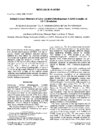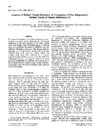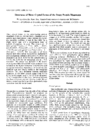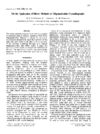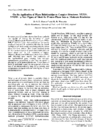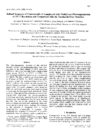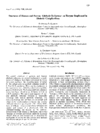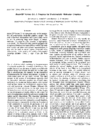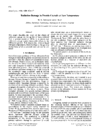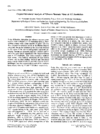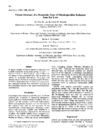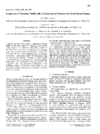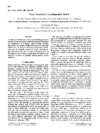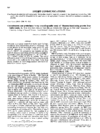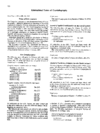issue contents
November 1994 issue

Cover illustration: The overall folding of the salmon trypsin molecule. Courtesy of A. O. Smalas and A Hordvik.
research papers
The resolution of the structure of dimeric horse liver alcohol dehydrogenase in complex with NADH and DMSO has been extended to 1.8 Å. Based on 62 440 unique reflections the structure was refined to an R factor of 16%.
PDB reference: 2ohx
Refinement of four independent models of human IL-1β indicates (1) r.m.s. errors 34 times that expected from Luzzati analysis, (2) less than a third of solvent molecules are common among the models and (3) a linear combination of models significantly lowered R values.
Determinations of the C2, P212121 and P41212 crystal forms of thaumatin were carried out by molecular replacement. The R values were 0.184, 0.165 and 0.181 after refinement at 2.6, 1.75 and 1.75 Å, respectively.
PDB reference: 1thu
The X-ray crystallographic structure of Acinetobacter glutaminasificans glutaminase-asparaginase has been reinterpreted and refined to an R factor of 0.171 at 2.9 Å resolution.
PDB reference: 1agx
Errors in data and complexity of structure are comparatively unimportant in the success of direct methods in solving oligonucleotides. The main factors for success are high-resolution data or, at lower resolutions, the presence of heavy atoms
A new figure of merit for protein phase sets is described, based on the property that electron density in the protein region has both a higher average value and a greater variance than in the solvent region.
Changes at the saccharide-binding site of concanavalin A involve re-orientation of the side chain of Tyrl00 and the expulsion of three ordered water molecules. Also, the monomers in the tetramer tend to separate slightly on sugar binding resulting in fewer inter-subunit interactions.
PDB reference: 5cna
The structure of aldehyde reductase consists of a β/α-barrel, with the coenzyme-binding site located at the carboxy-terminal end of the strands of the barrel.
PDB reference: 1alr
This freely available set of hardware-independent programs produces photorealistic figures for publication or lecture presentation.
The X-ray dose required to damage protein crystals at cryotemperatures is investigated. The results give limits to the size of protein crystal required for data collection.
Tobacco necrosis virus (TNV) with icosahedral T = 3 symmetry resembles southern bean mosaic virus (SBMV). TNV proteins have more disordered residues interacting with RNA than those of SBMV.
A binary complex of dihydropteridine reductase and NADH crystallizes in the space group C2. There are two dimers in the asymmetric unit. The structure was solved by molecular-replacement techniques and refined with 2.6 Å data to a crystallographic R factor of 16.8%.
PDB reference: 1hdr
Comparisons of the homology models with the final refined MIR structure are presented. Major discrepancies were found in critical active-site regions.
A protocol employing temperature factors, real-space-fit residuals, geometric strains, dihedral angles and shifts from the previous refinetnent cycle is developed to reliably detect errors in partially refined protein crystal structures.
Ribosome-inactivating protein from barley seeds has been crystallized and crystals have been characterized by collecting X-ray data to about 2.4 Å.
The tetrameric FAD-containing 2,4.pentadienoyl-CoA reductase from Clostridium aminovalericum has been crystallized in space group C2 (a = 160.2, b = 120.2, c = 95.3 Å, β = 99.0 °) using PEG as precipitant.
Crystals have been obtained for the Fabs of two anti-digoxin antibodies; one is complexed with the digoxin congener oubain.
international union of crystallography
Free 



 journal menu
journal menu











